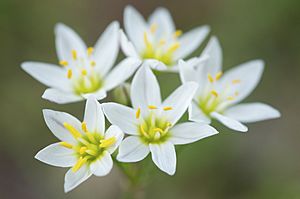Crowpoison facts for kids
Quick facts for kids Crowpoison |
|
|---|---|
 |
|
| Conservation status | |
| Scientific classification | |
| Genus: |
Nothoscordum
|
| Species: |
bivalve
|
| Synonyms | |
|
Species synonymy
Allium bivalve (L.) Kuntze
Allium bivalve var. bangii Kuntze Allium bivalve var. flavescens (Kunth) Kuntze Allium bivalve var. sellowianum (Kunth) Kuntze Allium bivalve var. striatum (Jacq.) Kuntze Allium canadense Michx. Allium flavescens Poepp. ex Kunth 1843, illegitimate homonym not Besser 1821 Allium geminatum Raf. Allium ornithogaloides Walter Allium sellowianum (Kunth) Regel Allium striatellum Lindl. Allium striatum Jacq. Allium subbiflorum Colla Brodiaea aurea Benth. & Hook. f. Brodiaea berteroi (Kunth) Fuentes Brodiaea subbiflora (Colla) Baker Geboscon bivalve (L.) House Geboscon geminatum (Raf.) Raf. Geboscon striatum (Jacq.) Raf. Hookera subbiflora Kuntze Milla subbiflora (Colla) Baker Nothoscordum flavescens Kunth Nothoscordum gramineum Beauverd Nothoscordum gramineum (Sims) P. Beauv. Nothoscordum gramineum var. flavescens Fuentes Nothoscordum gramineum var. philippianum Beauverd Nothoscordum gramineum var. vernum Fuentes Nothoscordum ornithogaloides (Walter) Kunth Nothoscordum philippianum Kunth & C.D.Bouché Nothoscordum sellowianum Kunth Nothoscordum striatellum (Lindl.) Kunth Nothoscordum striatum (Jacq.) Kunth Nothoscordum subbiflorum (Colla) Walp. Nothoscordum texanum M.E.Jones Oligosma bivalve (L.) Salisb. Ornithogalum bivalve L. Ornithogalum carolinianum Schult. & Schult.f. Ornithogalum gramineum Sims Ornithogalum pulchellum Salisb. Tristagma subbiflorum (Colla) Ravenna Triteleia berteroi Kunth |
|
Nothoscordum bivalve is a type of flowering plant. It is commonly known as crowpoison or false garlic. This plant grows naturally in many places. You can find it in the southern United States, from Arizona to Virginia. It also grows in Mexico, Peru, Uruguay, northeastern Argentina, and central Chile.
Contents
What is Crowpoison?
Crowpoison is a plant that comes back year after year. It grows from a small bulb, which is like a tiny onion, about 1 centimeter (0.4 inches) wide.
How Does It Grow?
- It usually has one straight stem, but sometimes it can have two.
- These stems can grow up to 40 centimeters (about 16 inches) tall.
- The plant has one to four thin leaves. These leaves can be up to 30 centimeters (about 12 inches) long.
Its Flowers
The flowers of the crowpoison plant grow in a cluster called an inflorescence. This cluster is shaped like an umbel, which means the flower stalks all come from one point, like the ribs of an umbrella.
- Each cluster usually has 3 to 6 flowers.
- Sometimes, you might see up to 10 flowers in one cluster.
- There are two small leaf-like parts, called bracts, at the bottom of the flower cluster.
- Each flower has six whitish tepals. Tepals are like petals and sepals combined.
- Most tepals have a dark reddish line running down the middle.
- These flowers do not have any scent.
- After the flower blooms, it forms a capsule. This capsule holds the seeds.
Where Does Crowpoison Live?
This plant is quite common and can be found in many different places.
- It often grows in parks and along roadsides.
- It likes soil that is not too dry or too wet.
- You might even see it growing well in lawns.
A Favorite for Butterflies
Crowpoison is an important plant for some small insects. It provides a lot of nectar, which is a sweet liquid that butterflies love to drink. Small butterflies, like the falcate orangetip, often visit crowpoison flowers for their nectar.


